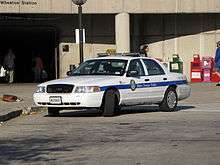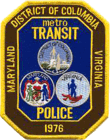Metro Transit Police Department
| Metro Transit Police Department | |
|---|---|
| Common name | Metro Transit Police |
| Abbreviation | MTPD |
|
Patch of the Metro Transit Police Department | |
|
Logo of the Washington Metropolitan Area Transit Authority | |
| Agency overview | |
| Formed | June 4, 1976 |
| Employees | 550 |
| Legal personality | Governmental: Government agency |
| Jurisdictional structure | |
| Legal jurisdiction | Washington, D.C., Maryland, Virginia (Defined in the WMATA Compact)[1] |
| Governing body | Washington Metropolitan Area Transit Authority |
| General nature | |
| Operational structure | |
| Agency executive | Ronald Pavlik, chief |
| Facilities | |
| Patrol cars | Ford Crown Victoria Police Interceptor |
| Website | |
|
http: | |
| Footnotes | |
The Metro Transit Police Department (MTPD) is the policing agency of the Washington Metropolitan Area Transit Authority (WMATA), created by the WMATA Compact on June 4, 1976.[1]
The Metro Transit Police Department is unique in American law enforcement as it is the only U.S. police agency that has full local police authority in three different jurisdictions (Maryland, Virginia and Washington, D.C.). The department has an authorized strength of 490 sworn officers, 170 Special Police Officers, and more than 100 civilian personnel. New officers complete 23 weeks of initial training at the Northern Virginia Criminal Justice Training Academy and then complete 15 additional weeks of training at the Metro Transit Police Academy.
The Metro Transit Police is accredited by the Commission on Accreditation for Law Enforcement Agencies.
Patrols
Uniformed and plainclothes Transit Police officers patrol the Metrorail system and Metrobuses on foot and on bicycles, and using motorcycles and marked and unmarked police cars. Transit Police Detectives provide investigative support. Transit Police officers have jurisdiction and arrest powers throughout the 1,500-square-mile (3,900 km2) Metro service area for crimes that occur on Transit Authority facilities,[2] or within 150 feet (46 m) of a Metrobus stop.[3]
Transit Police are actively involved in protecting Metro passengers and infrastructure from terrorist threats. After the September 11, 2001 attacks, the Madrid Train Bombing, and the London subway bombings, and periodically since, members of the Metro Transit Police Special Response Team conduct security sweeps of the rail system while armed with special weapons systems, H&K MP5 submachine guns and supported by explosive ordnance detection K-9 teams. Additionally, the department has a dedicated explosive disposal team.
Metro Police cars are issued standard District of Columbia passenger license plates same as civilian vehicles, but to make it more difficult for impostors to impersonate a transit police car, Metro installs its own police license plates on its cars.
History

Since the establishment of the Metro Transit Police Department, two officers have been killed in the line of duty.[4] Officer Harry Davis, Jr., was shot and killed in Landover, Maryland, while investigating a stolen vehicle parked at a Metro facility near the Landover station on December 20, 1993.[5] Officer Marlon Morales was shot in the District of Columbia by a fare evasion suspect at the U Street Metro station on June 10, 2001. Morales succumbed to his wounds and died on June 13, 2001.[6] The suspects in both murders were identified, captured, tried, and convicted.[6] Morales' killer was sentenced to life in prison without the possibility of parole.[5][6]
Local ordinances strictly forbid riders from eating or drinking while on a Metrorail train or in a station.[7][8][9][10][11] Officers are required to take police action when they observe any criminal activity, but arrests for these minor violations are rare. One exception was on October 23, 2000, when a 12-year-old girl was arrested, searched, and handcuffed for refusing to stop eating french fries while in the Tenleytown-AU Metro station. She was taken to a police juvenile processing area where she was booked, fingerprinted, and detained until her mother arrived to pick her up.[12] At the time of the incident, the Officer had no legal authority to take any formal action against a juvenile other than make an arrest. This policy has since been changed and Transit Police Officers may now issue written warnings to juvenile offenders. Another widely noted case occurred on July 16, 2004, when an EPA employee entered the Metro Center station with a PayDay candy bar. Before passing through the fare gates, patrolling police officers told her to finish eating before she could enter the paid area. Instead, she popped the last bite of the bar into her mouth, continuing to chew it while in the station. She was subsequently arrested after refusing to cooperate with the issuance of a citation for the offense.[13]
While sometimes seen as excessive, Metro's zero-tolerance policy, when it comes to crime, including eating, drinking, littering, and other forms of disorder, embodies the broken windows philosophy of crime reduction. According to criminal justice author Nancy G. La Vigne, Metro's attempts to reduce crime, combined with how the station environments were designed with crime prevention in mind,[14] has contributed to the fact that Washington Metro was regarded to be among the safest and cleanest subway systems in the United States in 1996.[15] This has recently been challenged in the media and community after several safety incidents including a full day shutdown on March 15, 2016.[16]
This philosophy also extends to use of station restroom facilities. Metro's long-standing policy restricts use of restrooms to only employees in order to prevent undesirable activity such as graffiti,[15] though station managers could make exceptions at their discretion, such as for customers with small children, the elderly or disabled, etc.[17] In 2003 Metro added a self-cleaning portable restroom for public use at the Huntington station.[17]
In 2003 a publicly posted policy change at each station indicated that, except at the three stations which do not have accessible restrooms (which will only be for use of Transit Authority personnel), passengers who request use of the restrooms will be permitted to do so, subject to the station manager being able to escort them to the restroom. The station manager does not have to wait for them to finish using the restroom, but is permitted to allow them to find their way out of the area where the restroom is located.
In spite of the "broken windows" philosophy, there was an increase in serious crime in 2010; for example, according to Metro statistics, there were 7 sexual assaults and 136 aggravated assaults reported in 2010,[18] compared with 1 sexual assault[19] and 91 aggravated assaults in 2009.[18]
See also
References
- 1 2 Washington Metropolitan Area Transit Authority (June 4, 1976). "Washington Metropolitan Area Transit Authority Compact". Washington Metropolitan Area Transit Authority. Washington Metropolitan Area Transit Authority. Archived from the original on December 15, 2008. Retrieved December 16, 2008.
- ↑ "About Metro - Transit Police". WMATA. Retrieved 2009-08-31.
- ↑ "Washington Metropolitan Area Transit Authority Compact" (PDF). Retrieved 2009-10-12.
- ↑ "Metro Transit Police Department, District of Columbia Fallen Officers". Odmp.org. Retrieved 2009-10-12.
- 1 2 "Officer Harry Davis Jr., Metro Transit Police Department". Odmp.org. 1993-12-20. Retrieved 2010-05-22.
- 1 2 3 "Officer Marlon Francisco Morales, Metro Transit Police Department". Odmp.org. Retrieved 2010-05-22.
- ↑ Alexandria (Va.) City Code, chapter 1, § 13-1-37
- ↑ Chapter 14.2, Arlington County (Va.) Code, Article IV
- ↑ District of Columbia Code, Title 35, Subtitle I, Chapter 2, Subchapter III
- ↑ Montgomery County (Md.) Code, Part II, chapter 54A Archived December 27, 2010, at the Wayback Machine.
- ↑ Prince George's County (Md.) Code, § 20A-102
- ↑ Hedgepeth v. Washington Metro. Area Transit Auth., 386 F.3d 1148 (D.C. Cir. 2004)
- ↑ Layton, Lyndsey (2004-07-29). "Mouthful Gets Metro Passenger Handcuffs and Jail". The Washington Post. pp. A01. Retrieved 2009-10-12.
- ↑ La Vigne, Nancy G. (November 1997). "Visibility and Vigilance: Metro's Situational Approach to Preventing Subway Crime (Research in Brief)" (PDF). National Institute of Justice, U.S. Department of Justice.
- 1 2 La Vigne, Nancy G. (1996). "Safe Transport: Security by Design on the Washington Metro (Chapter 6)". In Clarke, Ronald V. (editor). Preventing Mass Transit Crime. Criminal Justice Press. ISBN 1-881798-28-3.
- ↑ "All Metrorail service will be suspended Wednesday, March 16, for emergency inspections". 2016-03-15. Retrieved 2016-04-17.
- 1 2 Layton, Lyndsey (January 5, 2003). "If You Have to Go, Perhaps Soon You Can Go on Metro". The Washington Post.
- 1 2 Kytja Weir (2011-02-22). "Crime surges in Metro system". Retrieved 2011-03-04.
- ↑ "Crime Statistics - Five Year Crime Report".

